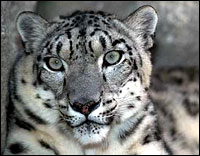Brad Rutherford is the executive director of the International Snow Leopard Trust, which works to conserve the endangered snow leopard in Central Asia by addressing the needs of local communities and the mountain ecosystemswhere they live.

Monday, 18 Aug 2003
SEATTLE, Wash.
I begin this weekly diary somewhat skeptical that readers of Grist will be interested in my “typical week.” Yet the commitment and generosity of people determined to save snow leopards and the environment often surprise me, so I will persevere.
It’s no easy trick to save snow leopards from Seattle, approximately 5,000 miles from the nearest wild one. The International Snow Leopard Trust was founded here in 1981 and has benefited from a close working relationship with Seattle’s Woodland Park Zoo and generous community members. The Seattle office leads our education and fundraising efforts but the bulk of our staff and resources are in the field. Fifteen of our 19 staff are based where the cats live, in Central Asia.
Today, like most days, I start off by checking my email — 49 messages this morning, which is not bad. With the time difference between here and Central Asia, most of my colleagues have finished their day’s work and are home in bed by the time I fire up my computer each morning.
Most of the emails are either from staff members or partner organizations, or they involve my work to raise funds for our programs. Communicating with our great field staff and partner organizations is always the most fun part for me. I look forward to hearing about how our programs are going or getting news of an exciting research find. Working on the fundraising is what keeps the programs going and invariably requires most of my attention. The good news is that the collaborative approach we are taking to snow leopard conservation is showing great results, which makes fundraising a bit easier. Today’s batch of emails also has several concerning last week’s release of the Snow Leopard Survival Strategy.

You can’t get a snow leopard to change its spots.
Photo: ISLT.
The strategy, a blueprint for how we can save the snow leopard in the wild, is the result of two years of collaboration between more than 65 scientists and conservationists worldwide. Everyone stays connected via an email discussion group and a website, and I find the spirit of collaboration truly inspiring. The network met here in Seattle last year during the height of tensions in Central Asia — conflicts between Pakistan and India, between Kyrgyzstan and Uzbekistan, between the U.S. and much of the region — and yet at no time during the week was any of that tension exhibited among the participants. The group is doing a great job of working together to save snow leopards and we are hoping the release of the report will lead to more effective conservation programs, more folks being educated about the plight of the endangered cat, and more money to support our work.
I was reminded how far we have to go in terms of educating folks about snow leopards this weekend. I was at the Danskin Triathlon cheering on my wife (way to go, Jillian!) and was talking to another man whose wife was also racing. The conversation turned to jobs and I mentioned that I am helping to save snow leopards. His response was, “I didn’t know there were snow leopards in the United States.” (For those of you who are new to snow leopard conservation and are interested in learning more about them, our website has lots of good information.)
Meanwhile, here’s a quick overview: The snow leopard has been listed as endangered by the World Conservation Union since 1972 and scientists estimate that there are between 3,500 and 7,000 cats remaining in the wild — roughly the same as the tiger, which is also endangered. The good news is the release of the Snow Leopard Survival Strategy did result in a special on National Geographic Today, BBC coverage, and several print stories, so we are making progress.
One of the good things that came across in the National Geographic story is the fact that our efforts to protect snow leopards involve working with local communities to create programs that, while focused on protecting snow leopards, also help improve the quality of life for the people who share the land with the cats. As the week goes on, I’ll write more about some of the programs we have developed that are saving snow leopards and raising incomes for project participants. Now, though, I better get to some of those fundraising emails that I need to answer if we want to save these animals.

